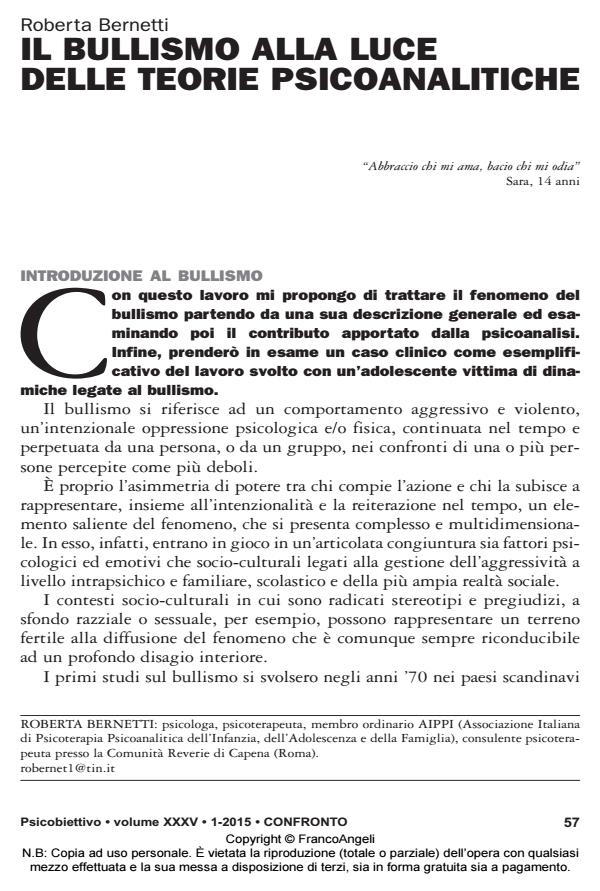Il bullismo alla luce delle teorie psicoanalitiche
Titolo Rivista PSICOBIETTIVO
Autori/Curatori Roberta Bernetti
Anno di pubblicazione 2015 Fascicolo 2015/1
Lingua Italiano Numero pagine 18 P. 57-74 Dimensione file 121 KB
DOI 10.3280/PSOB2015-001004
Il DOI è il codice a barre della proprietà intellettuale: per saperne di più
clicca qui
Qui sotto puoi vedere in anteprima la prima pagina di questo articolo.
Se questo articolo ti interessa, lo puoi acquistare (e scaricare in formato pdf) seguendo le facili indicazioni per acquistare il download credit. Acquista Download Credits per scaricare questo Articolo in formato PDF

FrancoAngeli è membro della Publishers International Linking Association, Inc (PILA)associazione indipendente e non profit per facilitare (attraverso i servizi tecnologici implementati da CrossRef.org) l’accesso degli studiosi ai contenuti digitali nelle pubblicazioni professionali e scientifiche
L’autore, partendo da una descrizione generale del bullismo, analizza il fenomeno dal punto di vista psicoanalitico tenendo conto dell’articolata sovrapposizione di fattori che, a livello intrapsichico e socio-culturale, entrano in gioco nella gestione dell’aggressività. Viene preso in considerazione il rapporto tra bullismo e gruppo e le caratteristiche che differenziano quest’ultimo dalla banda, creata attraverso un patto "offensivo" di coalizione tra i suoi membri contro l’esterno. Si esplora il legame tra aggressività, violenza e depressione in adolescenza e ci si interroga altresì sull’attuale diffusione del bullismo non soltanto in adolescenza e in pre-adolescenza, ma anche in età di latenza. Si approfondisce la distinzione tra un’aggressività fisiologica ed essenziale al transito in adolescenza verso un’identità adulta, e la distruttività. Viene altresì preso in considerazione il concetto di "dinamiche della banda interna", riferito ad un patto di fedeltà con un "gruppo interno" che svolgerebbe un ruolo difensivo contro il terrore della depressione: il bullismo appare come la manifestazione del sadismo di un’organizzazione interna che tiene il soggetto prigioniero. L’autore si sofferma sugli interventi terapeutici a suo avviso più utili, quindi sulla psicoterapia psicoanalitica e su un lavoro scolastico anche preventivo. Un caso clinico, infine, è esemplificativo del lavoro svolto con un’adolescente vittima di dinamiche legate al bullismo, in un contesto sociale attuale dominato dall’idealizzazione del corpo e dalla tendenza alla violenza di gruppo.
Parole chiave:Bullismo; aggressività; adolescenza; distruttività; banda interna; dipendenza.
- Handbook of Research on Applying Emerging Technologies Across Multiple Disciplines Raffaele De Luca Picione, Elvira Martini, Fabrizio Corona, Maria Libera Falzarano, Sara Cicchella, pp.352 (ISBN:9781799884767)
Roberta Bernetti, Il bullismo alla luce delle teorie psicoanalitiche in "PSICOBIETTIVO" 1/2015, pp 57-74, DOI: 10.3280/PSOB2015-001004